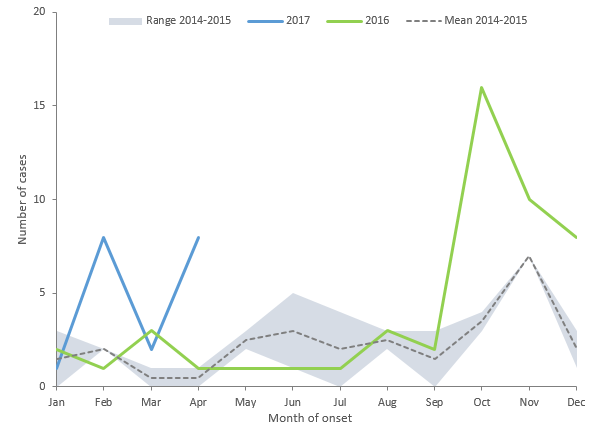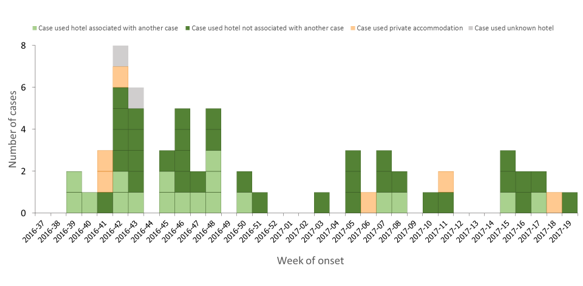Epidemiological update: Legionnaires’ disease cases associated with travel to Dubai, 24 May 2017
Increase in travel-associated Legionnaires’ disease among European travellers returning from Dubai since 1 October 2016. This epidemiological update is the third since a rapid risk assessment was published by ECDC on 23 December 2016.
The ECDC surveillance scheme (ELDSNet) for travel-associated Legionnaires’ disease (TALD) [1] has observed an increase in the number of cases associated with travel to Dubai, United Arab Emirates (UAE) since the beginning of the last quarter of 2016 compared to 2014-2015 (Figure 1). Case numbers reported in February and April 2017 continue to be significantly above that observed in recent years.

Figure 1. Distribution of TALD cases with a history of stay at commercial accommodations in Dubai (UAE) by month of onset until April 2017, EU/EFTA countries, 2014-2017, as reported by of 23 May 2017
As of 23 May 2017, 60 TALD cases with a history of visit to Dubai within 2–10 days prior to illness and with onset since 1 October 2016, have been reported to ECDC by EU Member States and one European Free Trade Association (EFTA) country. The most recent case date of illness onset is reported to be 11 May 2017.
Cases were reported by the United Kingdom (29 cases), Sweden (8), the Netherlands (6), Denmark (4), France (3), Germany (3), Austria (1), Belgium (1), the Czech Republic (1), Hungary (1), Ireland (1), Spain (1) and Switzerland (1). The delay between week of illness onset and week of reporting cases to ELDSNet is around two weeks, ranging from one to six weeks. Therefore, the number of cases reported in the past six weeks is likely to be underestimated.

Figure 2. Distribution of TALD cases with history of stay in Dubai (UAE), by week of onset and accommodation site clustering, weeks 37/2016–19/2017, reported as of 23 May 2017 (n=60)
Of the 60 reported cases having onset since 1 October 2016, 54 stayed at commercial accommodation site (hotel or apartment) and six used private accommodation sites. A total of eighteen cases used a hotel that was associated with another case falling ill since 1 October 2016. Twelve cases stayed at an accommodationtion in another location in UAE or in a country other than their home country during their incubation period. One case was reported as fatal. Thirteen cases had stayed in Dubai during the entire duration of their incubation period.
All cases are laboratory confirmed. Three of the cases had their infection further characterised as Legionella pneumophila serogroup 1 sequence base type 616 and one as Legionella pneumophila serogroup 1 sequence base type 2382. Sequence base type 616 is uncommon in Europe and has been associated with other Legionnaires’ disease cases returning from Dubai in previous years, while sequence base type 2382 is the first such identification worldwide and appears to be closely-related to type 616 (personal communication, ELDSNet network). One case has been characterised with Legionella pneumophila serogroup 13, sequence base type 1327.
The UAE authorities have informed ECDC that there was no increase observed in statutory notifiable pneumonia cases in Dubai during the period October to December 2016.
Environmental investigations
Public health authorities in the UAE has informed ECDC that environmental investigations were undertaken at the notified hotels and Legionella count results within the Dubai municipality showed acceptable levels for water systems (<1000 cfu/litre) [2]. The threshold of acceptability is the same as that indicated in the European technical guidelines by EWGLI [3].
According to UAE authorities risk assessment of all hotel accommodations notified through ELDSNet and of possible high risk sites such as cooling plants and major fountains has been undertaken in Dubai and no single source has been identified to date. It is also reported that Dubai Municipality continue to undertake investigations for any new cases notified by ELDSNet, as well as monitoring and surveillance according to Dubai laws and regulations.
ECDC threat assessment for the EU
The assessment outlined in the rapid risk assessment published on 23 December 2016 has not changed, since cases have continued to be reported with illness onset in recent weeks.






